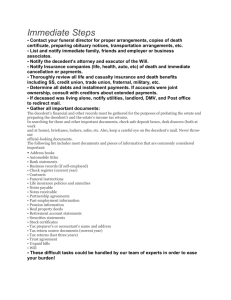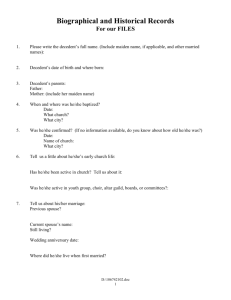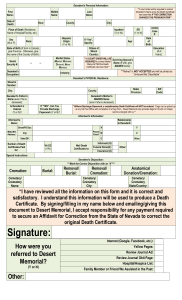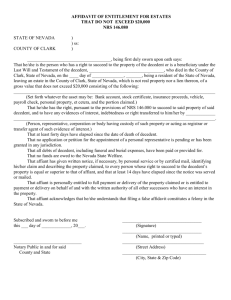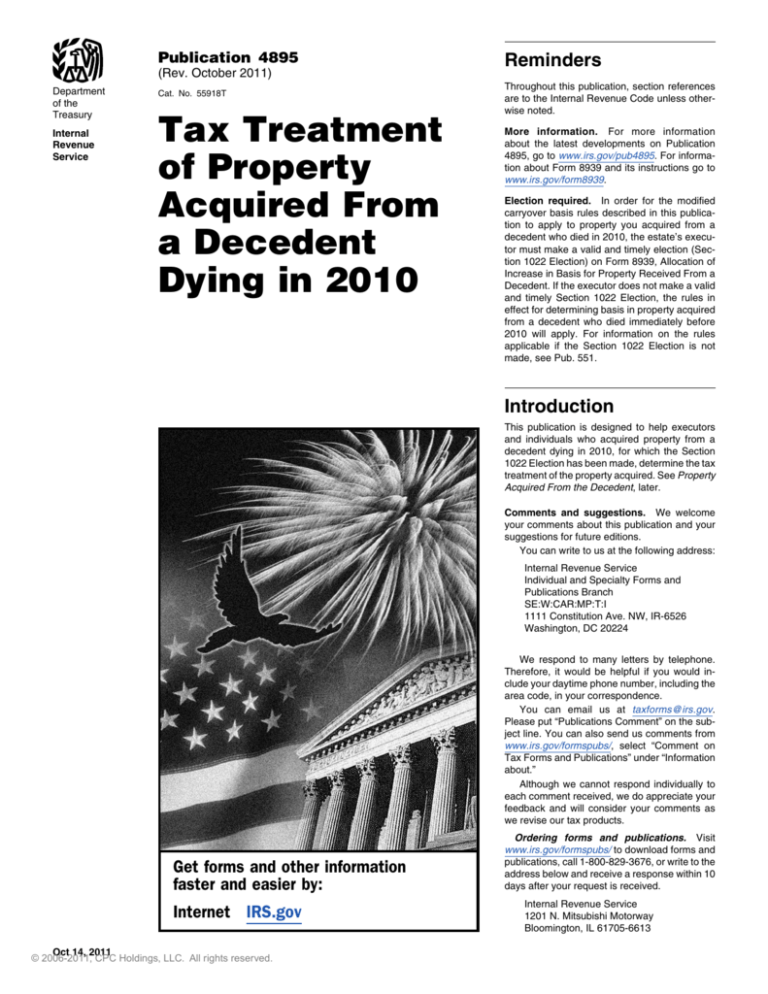
Publication 4895
(Rev. October 2011)
Department
of the
Treasury
Internal
Revenue
Service
Cat. No. 55918T
Tax Treatment
of Property
Acquired From
a Decedent
Dying in 2010
Reminders
Throughout this publication, section references
are to the Internal Revenue Code unless otherwise noted.
More information. For more information
about the latest developments on Publication
4895, go to www.irs.gov/pub4895. For information about Form 8939 and its instructions go to
www.irs.gov/form8939.
Election required. In order for the modified
carryover basis rules described in this publication to apply to property you acquired from a
decedent who died in 2010, the estate’s executor must make a valid and timely election (Section 1022 Election) on Form 8939, Allocation of
Increase in Basis for Property Received From a
Decedent. If the executor does not make a valid
and timely Section 1022 Election, the rules in
effect for determining basis in property acquired
from a decedent who died immediately before
2010 will apply. For information on the rules
applicable if the Section 1022 Election is not
made, see Pub. 551.
Introduction
This publication is designed to help executors
and individuals who acquired property from a
decedent dying in 2010, for which the Section
1022 Election has been made, determine the tax
treatment of the property acquired. See Property
Acquired From the Decedent, later.
Comments and suggestions. We welcome
your comments about this publication and your
suggestions for future editions.
You can write to us at the following address:
Internal Revenue Service
Individual and Specialty Forms and
Publications Branch
SE:W:CAR:MP:T:I
1111 Constitution Ave. NW, IR-6526
Washington, DC 20224
We respond to many letters by telephone.
Therefore, it would be helpful if you would include your daytime phone number, including the
area code, in your correspondence.
You can email us at taxforms@irs.gov.
Please put “Publications Comment” on the subject line. You can also send us comments from
www.irs.gov/formspubs/, select “Comment on
Tax Forms and Publications” under “Information
about.”
Although we cannot respond individually to
each comment received, we do appreciate your
feedback and will consider your comments as
we revise our tax products.
Get forms and other information
faster and easier by:
Internet IRS.gov
Oct 14, 2011
© 2006-2011, CPC Holdings, LLC. All rights reserved.
Ordering forms and publications. Visit
www.irs.gov/formspubs/ to download forms and
publications, call 1-800-829-3676, or write to the
address below and receive a response within 10
days after your request is received.
Internal Revenue Service
1201 N. Mitsubishi Motorway
Bloomington, IL 61705-6613
Tax questions. If you have a tax question,
check the information available on IRS.gov or
call 1-800-829-1040. We cannot answer tax
questions sent to either of the above addresses.
Useful Items
You may want to see:
Publication
❏ 551
Basis of Assets
❏ 555
Community Property
❏ 559
Survivors, Executors, and
Administrators
Form (and Instructions)
❏ 8939 Allocation of Increase in Basis for
Property Received From a
Decedent
❏ 706
United States Estate (and
Generation-Skipping Transfer) Tax
Return
Section 1022 Election
The executor of an estate of a decedent who
died in 2010 can elect to apply modified carryover basis treatment to property acquired from
the decedent under section 301(c) of the Tax
Relief, Unemployment Insurance Reauthorization, and Job Creation Act of 2010 (TRUIRJCA).
If the election is made, the estate will not be
subject to federal estate tax and does not need
to file a Form 706 even if the value of the estate
is $5,000,000 or more. As a result, section 1014
generally does not apply to determine the recipient’s basis in property acquired from the decedent. Instead, section 1022 applies to determine
the recipient’s basis in most (but not all) property
acquired from the decedent. This election is
referred to as the Section 1022 Election.
Form 8939
Form 8939 is an information return used by the
executor of a decedent who died in 2010:
1. To make the Section 1022 Election;
2. To report information about property acquired from a decedent (defined in Property Acquired From the Decedent, later);
and
3. To allocate Basis Increase (defined in Basis Increase, later) to certain property acquired from a decedent.
For detailed information about the Section
1022 Election, see Notice 2011-66, 2011-35
I.R.B. 184, available at www.irs.gov/irb/
2011-35_IRB/ar09.html and Notice 2011-76,
2011-40 I.R.B 479, available at www.irs.gov/irb/
2011-40_IRB/ar13.html. For optional safe harbor guidance under section 1022, see Revenue
Procedure 2011-41, 2011-35 I.R.B. 188, available at www.irs.gov/irb/2011-35_IRB/ar10/html.
The Section 1022 Election is made when the
executor timely files Form 8939. The due date
for Form 8939 is January 17, 2012. For more
information on the filing due date, see When to
File in the Instructions for Form 8939.
Page 2
© 2006-2011, CPC Holdings, LLC. All rights reserved.
Effect of the Section 1022
Election
If the executor makes the Section 1022 Election,
special rules apply. These rules include the following.
• There is no estate tax.
• The basis of property acquired from a decedent generally is determined under the
modified carryover basis rules of section
1022 and not under section 1014. Generally, the recipient’s basis is the lesser of
the decedent’s adjusted basis or the fair
market value (FMV) at the date of the decedent’s death, increased by any allocation of Basis Increase, and as further
adjusted as required by sections 1016,
1017, and 1018, or as otherwise specifically provided for under applicable provisions of Internal Revenue laws.
If the executor makes the Section 1022 Election and follows the provisions of section 4 of
Revenue Procedure 2011-41, and takes no return position contrary to any provisions of section 4, the IRS will not challenge the taxpayer’s
ability to rely on the provisions of section 4 on
either Form 8939 or any other return of tax.
Once made, the Section 1022 Election cannot be revoked after the due date for filing Form
8939.
Note. If the executor does not make a valid
and timely Section 1022 Election, the rules in
effect for determining basis in property acquired
from a decedent who died immediately before
2010 will apply.
Interaction of Section 1022
with Other Income Tax
Provisions
For information on how property acquired from
the decedent for which a Section 1022 Election
has been made is treated with respect to certain
income tax provisions (including holding period,
tax character, and depreciation) see Rev. Proc.
2011-41, section 4.06.
Statement to
Recipients
The executor filing Form 8939 must furnish a
Schedule A (Form 8939) to each person who
acquired property from the decedent, including
the following persons.
• The decedent’s surviving spouse.
• The trustee of a qualified terminable interest property (QTIP) trust.
• Any charitable remainder trust the sole
non-charitable beneficiary of which is the
decedent’s surviving spouse.
• Any other person (other than the executor
filing the return) who acquires property
from the decedent.
The executor must provide a Schedule A
(Form 8939) to each person who acquired property from the decedent no later than 30 days
after the date that the executor files Form 8939.
The executor must also provide amended or
supplemental Schedules A (Form 8939) in certain circumstances. For more information, see
Notice 2011-66.
The Schedule A (Form 8939) that the recipient of property receives should include the following information about the property acquired
from the decedent.
• A description of the property.
• The date the decedent acquired the property (to help determine the recipient’s
holding period in the property).
• The adjusted basis of the property on the
date of the decedent’s death.
• The FMV of the property on the date of the
decedent’s death.
• The amount of Basis Increase allocated to
the property.
• The amount, if any, of ordinary income
that would result on the sale of the property.
Property Acquired
From the Decedent
Generally, section 1022 determines a recipient’s
basis in property, but only if the property is
acquired from the decedent. Generally, property
acquired from the decedent includes the following.
1. Property acquired by bequest, devise, or
inheritance, or by the decedent’s estate
from the decedent.
2. Property transferred by the decedent during the decedent’s lifetime to:
a. A qualified revocable trust (as defined
in section 645(b)(1)), or
b. Any other trust with respect to which the
decedent reserved the right to make
any change in the enjoyment thereof
through the exercise of a power to alter,
amend, or terminate the trust.
3. Any other property passing from the decedent by reason of death to the extent that
such property passed without consideration.
Note. Section 1022 does not apply to a decedent’s interest in a QTIP trust or similar arrangement funded for the benefit of the
decedent by the decedent’s predeceased
spouse. A recipient’s basis in this property will
not be determined under section 1022.
Note. Section 1022 also does not apply to
property that constitutes a right to receive an
item of income in respect of a decedent under
section 691.
Publication 4895 (October 2011)
Property Eligible for
Increase to Basis
Generally, the executor can allocate additional
basis under section 1022 (up to the FMV of the
property) to property acquired from the decedent that was owned by the decedent at the time
of death.
Property Owned by the
Decedent at the Time of
Death
The basis of property acquired from the decedent can be increased by an allocation of Basis
Increase only if and to the extent the property
was owned by the decedent at the time of death.
For information about ownership, see Rules
relating to ownership, in the Instructions for
Form 8939.
Amount of Basis
Increase
The executor can allocate General Basis Increase (defined in General Basis Increase,
later), and/or Spousal Property Basis Increase
(defined in Spousal Property Basis Increase,
later) to eligible property (defined earlier) but not
in excess of the amount needed to increase the
decedent’s adjusted basis to the property’s FMV
as of the date of the decedent’s death. The
result is that, for each property, the sum of the
decedent’s adjusted basis in that property and
the Basis Increase allocated to that property
cannot exceed the FMV of that property on the
decedent’s date of death.
The executor can allocate Basis Increase to
property owned by and acquired from the decedent on a property-by-property basis. For example, the executor can allocate Basis Increase to
one or more shares of stock or to a particular
block of stock rather than to the decedent’s
entire holding of that stock.
Basis Increase may not be allocated separately to a life estate and remainder interest in
the same property.
Decedent’s Adjusted Basis
Generally, the adjusted basis of the property in
the hands of the decedent as of the date of the
decedent’s death is the decedent’s cost or other
basis, adjusted as required by sections 1016,
1017, and 1018, or as otherwise specifically
provided for under applicable provisions of Internal Revenue laws.
Fair Market Value (FMV)
Generally, for purposes of section 1022, the
FMV of property is the price at which the property would change hands between a willing
buyer and a willing seller, neither being under
any compulsion to buy or sell and both having
reasonable knowledge of the relevant facts.
Publication 4895 (October 2011)
© 2006-2011, CPC Holdings, LLC. All rights reserved.
Basis Increase
Basis Increase is the sum of the General Basis
Increase (defined below) and the Spousal Property Basis Increase (defined below).
General Basis Increase
General Basis Increase is the sum of the Aggregate Basis Increase (defined below) and the
Carryovers/Unrealized Losses Increase (defined in Rev. Proc. 2011-41). However, for a
decedent who was neither a resident nor citizen
of the United States, the General Basis Increase
is limited to the Aggregate Basis Increase (limited as described below).
Aggregate Basis Increase
Aggregate Basis Increase is $1,300,000. However, for a decedent who was neither a resident
nor citizen of the United States, the Aggregate
Basis Increase is $60,000.
Spousal Property Basis
Increase
Spousal Property Basis Increase is $3,000,000.
Generally, the executor can allocate Spousal
Property Basis Increase only to qualified
spousal property that was both acquired from
and owned by the decedent. Qualified spousal
property means:
• Outright transfer property; and
• Qualified terminable interest property.
For more information on outright transfer
property and QTIP, see Spousal Property Basis
Increase, in the Instructions for Form 8939.
As part of the TCE program, AARP offers the
Tax-Aide counseling program. To find the nearest AARP Tax-Aide site, call 1-888-227-7669 or
visit AARP’s website at
www.aarp.org/money/taxaide.
For more information on these programs, go
to IRS.gov and enter keyword “VITA” in the
upper right-hand corner.
Internet. You can access the IRS website at IRS.gov 24 hours a day, 7 days
a week to:
• E-file your return. Find out about commercial tax preparation and e-file services
available free to eligible taxpayers.
• Check the status of your 2011 refund. Go
to IRS.gov and click on Where’s My Refund. Wait at least 72 hours after the IRS
acknowledges receipt of your e-filed return, or 3 to 4 weeks after mailing a paper
return. If you filed Form 8379 with your
return, wait 14 weeks (11 weeks if you
filed electronically). Have your 2011 tax
return available so you can provide your
social security number, your filing status,
and the exact whole dollar amount of your
refund.
• Download forms, including talking tax
forms, instructions, and publications.
• Order IRS products online.
• Research your tax questions online.
• Search publications online by topic or
keyword.
• Use the online Internal Revenue Code,
regulations, or other official guidance.
• View Internal Revenue Bulletins (IRBs)
published in the last few years.
• Figure your withholding allowances using
Penalty Relief
For certain penalty relief related to the recipient’s income tax return and computing the recipient’s income tax liability, see Notice 2011-76.
the withholding calculator online at www.
irs.gov/individuals.
• Determine if Form 6251 must be filed by
using our Alternative Minimum Tax (AMT)
Assistant available online at www.irs.gov/
individuals.
• Sign up to receive local and national tax
news by email.
How To Get Tax Help
You can get help with unresolved tax issues,
order free publications and forms, ask tax questions, and get information from the IRS in several ways. By selecting the method that is best
for you, you will have quick and easy access to
tax help.
Free help with your return. Free help in preparing your return is available nationwide from
IRS-certified volunteers. The Volunteer Income
Tax Assistance (VITA) program is designed to
help low-moderate income taxpayers and the
Tax Counseling for the Elderly (TCE) program is
designed to assist taxpayers age 60 and older
with their tax returns. Most VITA and TCE sites
offer free electronic filing and all volunteers will
let you know about credits and deductions you
may be entitled to claim. To find the nearest
VITA or TCE site, visit IRS.gov or call
1-800-906-9887 or 1-800-829-1040.
• Get information on starting and operating
a small business.
Phone. Many services are available by
phone.
• Ordering forms, instructions, and publications. Call 1-800-TAX -FORM
(1-800-829-3676) to order current-year
forms, instructions, and publications, and
prior-year forms and instructions. You
should receive your order within 10 days.
• Asking tax questions. Call the IRS with
your tax questions at 1-800-829-1040.
• Solving problems. You can get
face-to-face help solving tax problems
every business day in IRS Taxpayer Assistance Centers. An employee can explain IRS letters, request adjustments to
Page 3
your account, or help you set up a payment plan. Call your local Taxpayer Assistance Center for an appointment. To find
the number, go to www.irs.gov/localcontacts or look in the phone book under
United States Government, Internal Revenue Service.
• TTY/TDD equipment. If you have access
to TTY/TDD equipment, call
1-800-829-4059 to ask tax questions or to
order forms and publications.
• TeleTax topics. Call 1-800-829-4477 to listen to pre-recorded messages covering
various tax topics.
• Refund information. To check the status of
your 2011 refund, call 1-800-829-1954 or
1-800-829-4477 (automated refund information 24 hours a day, 7 days a week).
Wait at least 72 hours after the IRS acknowledges receipt of your e-filed return,
or 3 to 4 weeks after mailing a paper return. If you filed Form 8379 with your return, wait 14 weeks (11 weeks if you filed
electronically). Have your 2011 tax return
available so you can provide your social
security number, your filing status, and the
exact whole dollar amount of your refund.
If you check the status of your refund and
are not given the date it will be issued,
please wait until the next week before
checking back.
• Other refund information. To check the
status of a prior-year refund or amended
return refund, call 1-800-829-1040.
Evaluating the quality of our telephone
services. To ensure IRS representatives give
accurate, courteous, and professional answers,
we use several methods to evaluate the quality
of our telephone services. One method is for a
second IRS representative to listen in on or
record random telephone calls. Another is to ask
some callers to complete a short survey at the
end of the call.
Walk-in. Many products and services
are available on a walk-in basis.
• Products. You can walk in to many post
offices, libraries, and IRS offices to pick up
certain forms, instructions, and publications. Some IRS offices, libraries, grocery
stores, copy centers, city and county government offices, credit unions, and office
supply stores have a collection of products
available to print from a CD or photocopy
from reproducible proofs. Also, some IRS
offices and libraries have the Internal Revenue Code, regulations, Internal Revenue
Bulletins, and Cumulative Bulletins available for research purposes.
• Services. You can walk in to your local
Taxpayer Assistance Center every business day for personal, face-to-face tax
help. An employee can explain IRS letters,
request adjustments to your tax account,
or help you set up a payment plan. If you
need to resolve a tax problem, have questions about how the tax law applies to your
individual tax return, or you are more comfortable talking with someone in person,
visit your local Taxpayer Assistance
Page 4
© 2006-2011, CPC Holdings, LLC. All rights reserved.
Center where you can spread out your
records and talk with an IRS representative face-to-face. No appointment is necessary — just walk in. If you prefer, you
can call your local Center and leave a
message requesting an appointment to resolve a tax account issue. A representative will call you back within 2 business
days to schedule an in-person appointment at your convenience. If you have an
ongoing, complex tax account problem or
a special need, such as a disability, an
appointment can be requested. All other
issues will be handled without an appointment. To find the number of your local
office, go to
www.irs.gov/localcontacts or look in the
phone book under United States Government, Internal Revenue Service.
Mail. You can send your order for
forms, instructions, and publications to
the address below. You should receive
a response within 10 days after your request is
received.
Internal Revenue Service
1201 N. Mitsubishi Motorway
Bloomington, IL 61705-6613
Taxpayer Advocate Service. The Taxpayer
Advocate Service (TAS) is your voice at the IRS.
Our job is to ensure that every taxpayer is
treated fairly, and that you know and understand
your rights. We offer free help to guide you
through the often-confusing process of resolving
tax problems that you haven’t been able to solve
on your own. Remember, the worst thing you
can do is nothing at all.
TAS can help if you can’t resolve your problem with the IRS and:
• Your problem is causing financial difficul-
ties for you, your family, or your business.
• You face (or your business is facing) an
immediate threat of adverse action.
• You have tried repeatedly to contact the
IRS but no one has responded, or the IRS
has not responded to you by the date
promised.
If you qualify for our help, we’ll do everything
we can to get your problem resolved. You will be
assigned to one advocate who will be with you at
every turn. We have offices in every state, the
District of Columbia, and Puerto Rico. Although
TAS is independent within the IRS, our advocates know how to work with the IRS to get your
problems resolved. And our services are always
free.
As a taxpayer, you have rights that the IRS
must abide by in its dealings with you. Our tax
toolkit at www.TaxpayerAdvocate.irs.gov can
help you understand these rights.
If you think TAS might be able to help you,
call your local advocate, whose number is in
your phone book and on our website at www.irs.
gov/advocate. You can also call our toll-free
number at 1-877-777-4778 or TTY/TDD
1-800-829-4059.
TAS also handles large-scale or systemic
problems that affect many taxpayers. If you
know of one of these broad issues, please report
it to us through our Systemic Advocacy Management System at www.irs.gov/advocate.
Low Income Taxpayer Clinics (LITCs).
Low Income Taxpayer Clinics (LITCs) are independent from the IRS. Some clinics serve individuals whose income is below a certain level
and who need to resolve a tax problem. These
clinics provide professional representation
before the IRS or in court on audits, appeals, tax
collection disputes, and other issues for free or
for a small fee. Some clinics can provide information about taxpayer rights and responsibilities in many different languages for individuals
who speak English as a second language. For
more information and to find a clinic near you,
see the LITC page on www.irs.gov/advocate or
IRS Publication 4134, Low Income Taxpayer
Clinic List. This publication is also available by
calling 1-800-829-3676 or at your local IRS office.
Free tax services. Publication 910, IRS
Guide to Free Tax Services, is your guide to IRS
services and resources. Learn about free tax
information from the IRS, including publications,
services, and education and assistance programs. The publication also has an index of over
100 TeleTax topics (recorded tax information)
you can listen to on the telephone. The majority
of the information and services listed in this
publication are available to you free of charge. If
there is a fee associated with a resource or
service, it is listed in the publication.
Accessible versions of IRS published products are available on request in a variety of
alternative formats for people with disabilities.
DVD for tax products. You can order
Publication 1796, IRS Tax Products
DVD, and obtain:
• Current-year forms, instructions, and publications.
• Prior-year forms, instructions, and publications.
• Tax Map: an electronic research tool and
finding aid.
• Tax law frequently asked questions.
• Tax Topics from the IRS telephone response system.
• Internal Revenue Code — Title 26 of the
U.S. Code.
• Links to other Internet based Tax Research Materials.
• Fill-in, print, and save features for most tax
forms.
• Internal Revenue Bulletins.
• Toll-free and email technical support.
• Two releases during the year.
– The first release will ship the beginning
of January 2012.
– The final release will ship the beginning
of March 2012.
Purchase the DVD from National Technical
Information Service (NTIS) at www.irs.gov/
cdorders for $30 (no handling fee) or call
1-877-233-6767 toll free to buy the DVD for $30
(plus a $6 handling fee).
Publication 4895 (October 2011)

